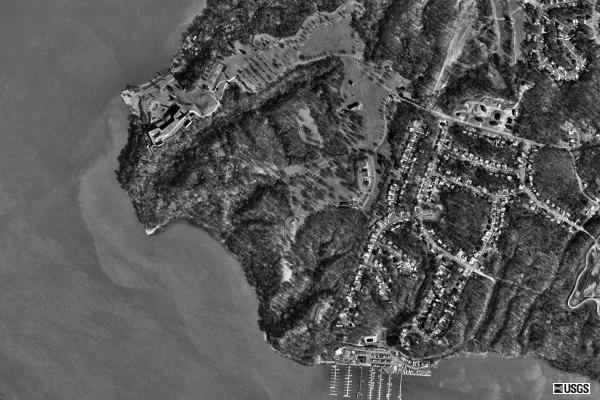
USGS Satellite Image of the fort
courtesy of Microsoft TerraServer
Proceed to Old Fort Photo Gallery

Proceed to Coastal Batteries Photo Gallery
Fort Washington was part of the Harbor Defenses of
Washington D.C.
Originally, Fort Warburton was built (in 1809) but it was destroyed in 1814 to
prevent the British from capturing it. The Brits continued upriver and burned the
Capital.
The fort area now consists of the Second System stone fort and Endicott batteries
from the Spanish-American War and World War I. The Army reoccupied the reservation
on Feb. 1 1937 and stayed throughout World War II. More recently, the Army has reoccupied
the site around the lighthouse in the name of Homeland Security.
The Counterscarp Gallery & Mortar Battery protected the right wall of the fortress.
Battery Emory and Battery Many are hidden in the forest, but generally still
accessable. Battery White was built over top of the Ravelin, and the
Water Battery once stood in the Ravelin, but was moved to near Battery
Humphreys.
A lighthouse was here from 1870 to 1901. Since 1901, the lighthouse's bell tower has
been used as the lighthouse.
Learn more about Ft Washington Light.
The Endicott and World War I Periods
BATTERIES & BUNKERS:
Mine Casemate 1 (1890's)
Mine Casemate 2: inside old fort casemates
Battery Meigs: eight 12-inch mortars (1902-1914)
Battery Decatur: two 10-inch guns on disappearing carriages (1899-1918)
Battery Emory: two 10-inch guns on disappearing carriages (1898-1929); one removed 1915.
{two different gun carriages}
Battery Humphreys: two 10-inch guns on disappearing carriages (1899-1929)
Battery Wilkin: two 6-inch guns on disappearing carriages (1902-1928)
Battery White: two 4-inch guns on pedestal mounts (1899-1921)
Battery Smith: two 3-inch masking parapet mount guns (1903 - 1920)
Battery Many: two 3-inch pedestal mounted guns (1905-1928)
Ravelin: four Rodman guns (1820-1830)
Water Battery: one 10-inch gun on a barbette carriage (1896-1898); replaced by Battery White
Command Posts
Fire Control Towers

USGS Satellite Image of the fort
Proceed to Old Fort Photo Gallery

Proceed to Coastal Batteries Photo Gallery